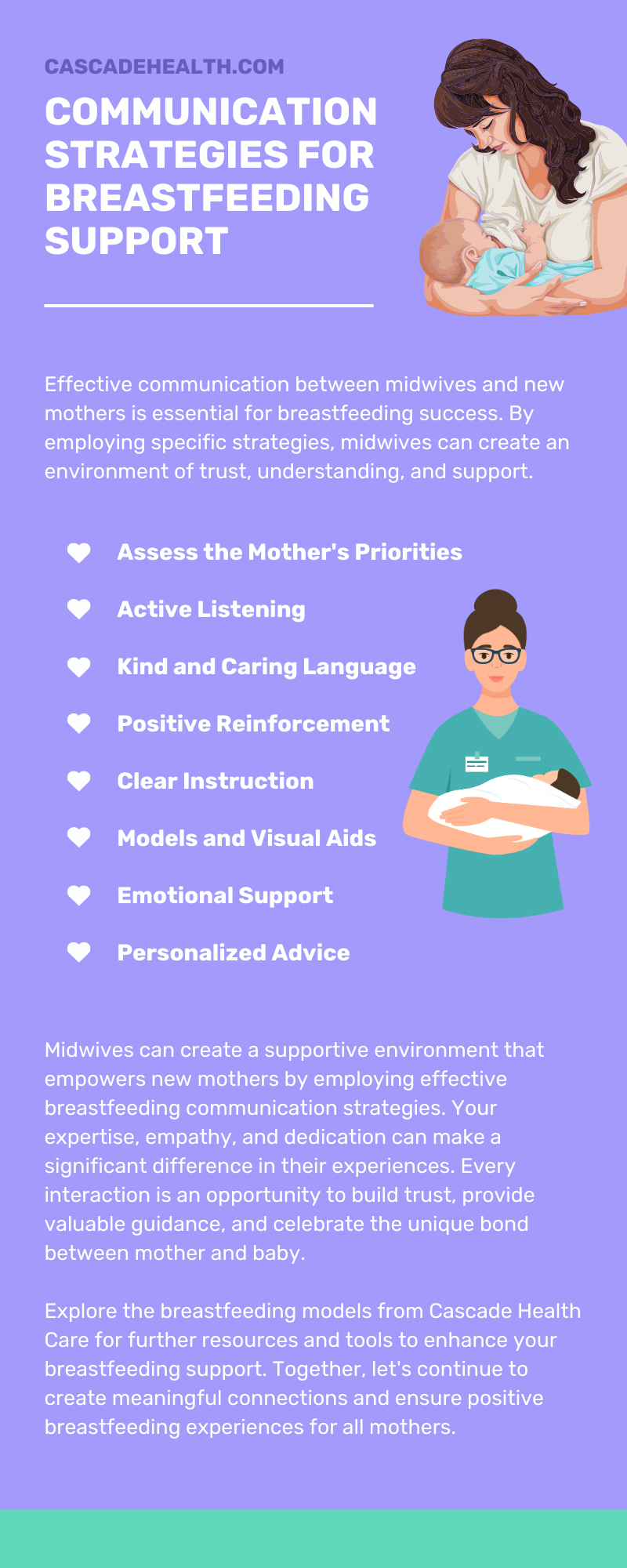Communication Strategies for Breastfeeding Support
Supporting new mothers in their breastfeeding journey is both an art and a science. For midwives, effective communication is integral to this support to address the myriad challenges and misconceptions that can arise.
Employing the right communication strategies for breastfeeding support lets you provide invaluable assistance, ensuring positive experiences for both mother and baby.
The Needs of New Mothers When Breastfeeding
Breastfeeding is a unique and profoundly personal experience for every new mother. It comes with its own emotional and physical needs, especially for those embarking on this journey for the first time.
New mothers often face a mix of excitement, anxiety, and uncertainty as they learn to breastfeed. Understanding these needs helps midwives provide the support new mothers require.
Emotionally, new mothers need reassurance and empathy. They may feel overwhelmed by the responsibility of caring for a newborn and the pressure to successfully breastfeed. Physically, they may experience discomfort, soreness, and fatigue. Recognizing these challenges and offering a compassionate ear can ease their concerns and build trust.
Additionally, new mothers benefit from practical guidance and encouragement. They need clear, accessible information about breastfeeding techniques and positions. Providing this information in a supportive and nonjudgmental manner can empower them to overcome obstacles and feel more confident in their abilities.
The Role of Midwives
Midwives play a pivotal role in supporting new mothers on their breastfeeding journeys. Their expertise and experience make them trusted sources of guidance and reassurance. Fostering strong, communicative relationships with new mothers allows midwives to help these women navigate the complexities of breastfeeding with greater ease.
One critical role of midwives is to provide evidence-based information and practical advice. They can educate mothers about the benefits of breastfeeding, common challenges, and effective techniques. Sharing this knowledge lets midwives empower mothers to make informed decisions and feel more confident in their breastfeeding abilities.
Midwives also offer emotional support, acknowledging the highs and lows of the breastfeeding experience. They can validate mothers’ feelings, provide reassurance during difficult moments, and celebrate their successes. This emotional connection builds a foundation of trust and encourages mothers to seek help when needed.
Communication Strategies for Breastfeeding Success
Effective communication between midwives and new mothers ensures breastfeeding success. Employing specific strategies lets midwives create an environment of trust, understanding, and support.
Below, we explore several key communication strategies to enhance breastfeeding support.
Assess the Mother’s Priorities
Understanding each mother’s unique priorities allows midwives to provide tailored support. Open a dialogue with the mother to discuss her breastfeeding goals and any concerns she may have. This conversation allows you to align your guidance with her expectations and needs.
For instance, some mothers may prioritize exclusive breastfeeding, while others may want to supplement with formula. Knowing these preferences helps you provide relevant advice and avoid suggesting methods that may not align with the new mother’s goals. This personalized approach fosters a sense of collaboration and respect.
Practice Active Listening
Active listening is a fundamental aspect of effective communication. Pay close attention to the mother’s concerns and questions, ensuring she feels heard and understood. Listen to her words, observing her body language and emotional cues.
When you actively listen, you demonstrate that you value the mother’s perspective and are genuinely invested in her well-being. This validation can alleviate feelings of isolation and frustration, creating a more positive and supportive environment for breastfeeding.
Use Kind and Caring Language
The words you choose when communicating with new mothers can have a profound impact on their experience. Use kind and caring language that conveys empathy and understanding. Avoid using overly technical terms or medical jargon, as this can create confusion and anxiety.
Instead, use reassuring language that makes the mother feel comfortable and supported. Highlighting the natural and beautiful aspects of breastfeeding can also build a positive mindset and reinforce the mother’s confidence.
Implement Positive Reinforcement
Encouragement and praise are powerful motivators for new mothers. Acknowledge and celebrate their efforts and progress, no matter how small. Positive reinforcement boosts their confidence and motivation, making them more likely to persevere through challenges.
For example, if a mother successfully latches her baby for the first time, offer genuine praise and highlight the significance of this achievement. Small victories can profoundly impact a mother’s overall outlook and determination.
Provide Clear Instruction
Providing clear and straightforward guidance helps new mothers master breastfeeding techniques and positions. Break down complex instructions into simple, step-by-step directions, and avoid overwhelming the mother with too much information at once.
Use nonjudgmental language. Frame your instructions in a supportive and empowering manner, emphasizing that learning to breastfeed is a gradual process. Remind the mother that it’s okay to make mistakes and that you’re there to support her every step of the way.
Use Models and Visual Aids
Visual aids can significantly enhance the effectiveness of your communication. Use diagrams, videos, breastfeeding models, or actual demonstrations to visually explain breastfeeding methods and tips. These tools provide a clear and tangible reference for mothers to follow.
For instance, demonstrating proper latch techniques using a breastfeeding model can help mothers visualize the correct positioning and attachment. Visual aids also serve as valuable resources that mothers can refer to on their own, reinforcing their learning outside of consultations.
Offer Emotional Support
Offering emotional support is a crucial component of breastfeeding support. Acknowledge the emotional and physical challenges of breastfeeding and provide reassurance and empathy. Normalize the range of emotions that mothers may experience, from joy and fulfillment to frustration and exhaustion.
Creating a safe space encourages mothers to share their feelings openly. This emotional connection fosters trust and encourages mothers to seek help when encountering difficulties, knowing they won’t be judged or criticized.
Provide Personalized Advice
Every mother and baby pair are unique, and thus need personalized advice for addressing their needs and circumstances. Tailor your guidance to suit the preferences, lifestyle, and challenges of each pair.
For example, if a mother has a busy schedule, suggest breastfeeding positions conducive to multitasking. If a baby has difficulty latching, offer techniques that address their specific issues. Personalized advice shows you understand and respect the mother’s situation, enhancing the overall support experience.
Find the Right Tools From Cascade Health Care
Midwives create a supportive environment that empowers new mothers by employing effective breastfeeding communication strategies. Your expertise, empathy, and dedication can make a significant difference in a new mother’s experiences. Every interaction presents an opportunity to build trust, provide valuable guidance, and celebrate the unique bond between mother and baby.
Explore the breastfeeding models from Cascade Health Care to enhance breastfeeding support. Together, let’s continue to create meaningful connections and ensure positive breastfeeding experiences for more mothers.

Recent Posts
-
Ophthalmic Tools and Techniques: Innovations in Eye Care
Vision is one of our most vital senses, and preserving it requires precision, expertise, and the rig
-
Comparing Different Types of Home Birth Pools
When you're planning a home birth, the right environment can shape the entire experience for your bi



